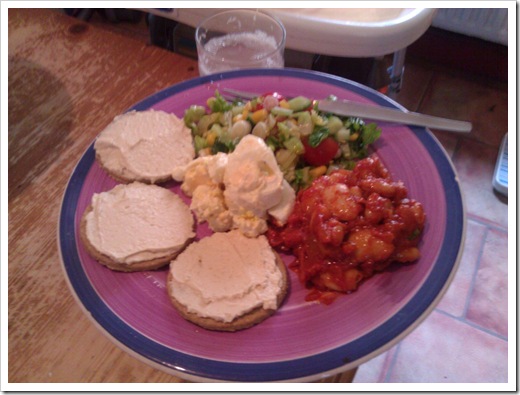Low GI – the vegetarian way
Chris and I are trying to lose weight and get healthier and fitter and, in terms of diet, we’ve found aiming for a low- to medium-GI diet works well for us. We had both lapsed considerably over the summer and are trying to get back on track – both in terms of our diet and exercise. I’ve started running, doing sit-ups and have been sent a Zumba DVD to try out, which I started yesterday (and today everything aches). Chris is jogging with the dog, doing sit-ups, doing a weight-lifting routine and going on long walks.
Chris’s version of the low-GI diet is high in protein and very low in carbohydrates and he has a lot of choice because he can have various meats, fish and seafood. It’s a bit difficult to do high protein when you’re vegetarian, though, especially if you want to keep the high-fat dairy foods to a minimum. Eggs are great, but you can have too many of them. So I am using Rose Elliot’s Low-GI vegetarian Vegetarian Cookbook as a basis, which doesn’t cut out carbohydrates entirely. You can keep the good ones (the slow-release energy ones, essentially) such as oats, wholemeal bread, al dente pasta, buckwheat and quinoa (though bread and pasta should be kept to lower quantities when trying to lose weight).
Beans and pulses are fantastic, because they combine slow-release carbohydrates and protein really well. Having at least one bean- or pulse-based meal a day makes a huge difference to me, reducing my desire for snacks between meals and they also seem to help the weight drop off. I’ve been back on track for only about a week and have already dropped 7lb (still 5lbs to go before I’m back to where I was before the summer slump, though).
The other big thing we’re doing is to have lots of salads. We like to have two or three salads on the go and normally make enough to last for at least two meals, sometimes three (any more and the freshness is completely gone).
Lemon juice and olive oil can reduce the GI of a meal, so if you have your salad dressed with this (vinegar works too), then you can have a bit of medium- or high-GI foods if you want (potatoes are the ones that I want the most).
For snacking, the best savoury thing is salted popcorn. Popcorn seems to have a miraculous weight-loss effect, though I can’t find any documentation to scientifically prove this. Oatcakes are good too, especially spread with lashings of hummus (pulses, olive oil and lemon juice!) The best sweet snacks are fruit, but I’m not very good at just eating a piece of fruit, so I like to have a fruit salad in the fridge to dip into. Chris likes a sliced apple with some Greek yoghurt – or the yoghurt with some breakfast topping mix. Special K is good too and I like to mix mine with some banana and raisins (though they’re not technically low GI). A couple of chunks of dark chocolate are good, too!
After a couple of weeks (I’m not quite there yet) you stop craving high GI stuff (not completely, of course!) and you also want less snacks in between meals. And I find the need to finish the girls’ meals dissipates, too – especially if they’ve got something with a high GI.
I’m not sure what makes us slide away from the low GI diet, though, as we did over the summer, because it honestly feels great when we’re sticking to it – as long as you keep to predominantly low GI meals, you can have the odd baked potato, chips or ice cream. (One great and odd thing is that a low GI meal plays forward – a beany meal with lots of salad at lunchtime means you can cope with a high GI meal at dinnertime, for example.) But I think there’s still that underlying idea that it’s a diet rather than a new healthier way of eating, so you need to reward yourself by stuffing yourself full of the things you’ve denied yourself.
I’m hoping not to slip down that route again.
Have you tried Low GI? What’s your preferred weight loss system? What exercises do you do?


Leave a Reply